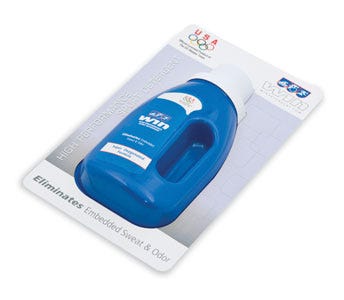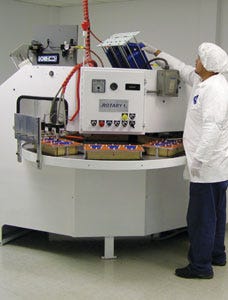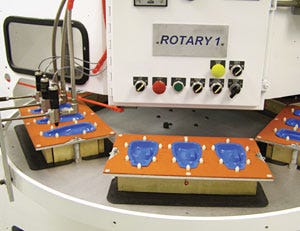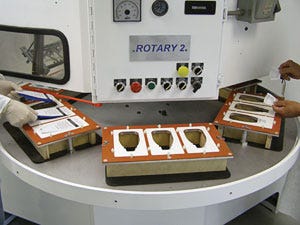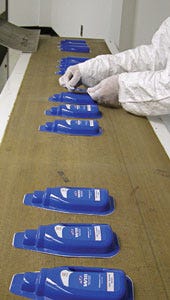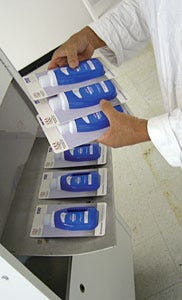Sports detergent in single-use blister packs for Olympics
January 30, 2014
|
According to Win Products Inc., Atlanta, many liquid detergents do not target embedded odors. Even after gym clothes are washed, these odors stay entrenched in the fibers. After a few workouts, even high tech fabrics can develop musty odors, which are caused by bacteria attracted to the sweat-soaked fabrics. To address this problem, the company developed its Win High Performance Sports Detergent, which breaks down embedded sweat molecules and other materials that can contribute to odor, then washes them away.
One year after the debut, Win High Performance Sports Detergent became an official licensed laundry detergent for the U.S. Olympic team and was distributed at the 2006 Olympic Winter Games in Torino, Italy. In preparation for the Olympic team's participation in the Beijing 2008 Games of the XXIX Olympiad, Win decided to develop a single-use package that not only offered convenience to the athletes but also would have branding benefits for the detergent distributor.
|
To be able to fill the blister packs with the high-oxygenated detergent, existing machinery was custom configured with corrosive-resistant lines. |
Team effort
To help develop the new packaging, Win approached Sonic , a specialty packaging company that prides itself on its consultative approach.
Prior to working with Sonic, Win was using a laminated pouch for the single-use size. “It didn't present the high-end feeling of the brand that we try to engender with the rest of the marketing mix,” recalls Win Products COO Jeff Crow.
According to Howard Thau, president of Sonic Packaging, the single-use pouch didn't offer robust protection for the aggressive detergent and it also lacked an important branding element: packaging identity value.
The companies decided to create a replica of the 21-oz bottle and incorporate a card with advertising and promotional information that also would carry a USA Olympic ring logo. This format is designed to help recipients identify the detergent so when they got back to the U.S., they could easily identify the detergent in the 21-oz retail size. The card also would allow a large image area for copy.
|
Blister pieces are manually placed in stands, which both support and correctly space the pieces for filling. |
To thermoform and fill the replica bottle, Sonic decided to put Win's best interest in mind and not fill the bottle itself. Instead, Sonic brought in a partner: Package Development Co. (PDC). Located in a 85,000-sq-ft facility in Rockaway, NJ, PDC is a custom package manufacturer and contract packer with the thermoforming, product handling and heat sealing experience required for the job. PDC also was willing to make the equipment modifications required to fill the oxygenated detergent.
According to PDC president Skip Schwester, the company thrives on challenging work and was eager to work with Win and Sonic to create an unusual, single-use package that addressed chemical compatibility and marketing needs.
The design that was decided upon was a blue thermoformed blister that would look like a miniature of the retail detergent bottle. This blister would have a multi-layer sealing backer. The sealed blister would be encased by two cards without a perforated opening. Marketing messages would be carried on the card's graphics and a label placed onto the blue blister.
|
An operator lifts filled blisters with their peelable backers, left, from a stand. Right, an operator lays down the first thermoformed piece of the three-part blister. |
Measured to size
PDC first needed to obtain all the geometries off of the full-size bottle. “After physically measuring the full-scale bottle, we scaled it down to the size that was appropriate to hold the fluid content and also carry the presence and the size that Win was looking for,” Schwester recalls.
PDC then manufactured a solid three-dimensional model of the bottle-shaped blister to help Win determine the size of the final container. According to Schwester, it was important to make sure that Win had solid models to handle and visualize because the size of the blister wasn't dependent only on how much liquid it would hold. To place more copy onto the blister and give the entire single-use packaging more of a presence, the final blister was developed to be larger than what is required to contain 3 oz of detergent.
|
The single-use package captured the New Jersey Packaging Executive Club’s 2008 Gold Award for promotional packaging. |
For chemical compatibility with the peroxided and highly oxygenated detergent, PVC was chosen. “When the detergent gases out the oxygen that is embedded in the detergent manufacturing process, the oxygen needs to go someplace or it becomes trapped within the package and will fill up like a balloon,”
Schwester explains. For these reasons, the company also chose PVC as one of the materials in the multilayered peelable backing for the blister.
PDC employed Armac brand fully automatic, in-line, form/trim/stack thermoformers to manufacture anywhere from 20,000 to 24,000 blue PVC bottle-shaped blisters/day. (Armac thermoformers are distributed by Sencorp Inc.)
The original design for the single-use detergent packaging did not include a replica of the white bottle cap that is used for the retail size.
|
An operator hand labels filled blisters. |
Scope creep, no problem
Near the end of the planning conversations between the three companies, it became apparent to Win that the white bottle cap was a distinctive part of its packaging and eliminating the cap from the single-use packs would be a mistake.
But adding the white cap to the packaging at this stage could be time consuming and financially devastating.
“For the volume and the size of the job, it didn't make sense to build what could be potentially $30,000 to $40,000 worth of parts and tools to make the cap,” remarks Schwester. “We didn't want to do it at first, but they [Win] insisted on it.” On top of the high costs that could be incurred by expanding the project's scope at this time, PDC had a very finite deadline because the packs needed to be at the Beijing Olympics—ready for distribution to the U.S. Olympic Team.
Expedient solution found
They already concluded that it was cost-prohibitive to build the punching tools to do this in a typical production fashion. Instead, PDC used an old, single-station hot-stamper to manufacture a thermoformed piece with two cap shapes in profile.
The outer edges of each thermoform resemble a bottle cap; the center of each piece was formed to resemble the bottom of the cap. Each piece was steel-rule die-cut in the center to create two “caps” for each bottle-shaped blister.
“It was a quick way to make the caps based on the deadline that we had,” Schwester explains. “In the end, what we always try to do is keep the company's marketing objectives in mind. The cap was critical for them, so we found a way to do it.”
Sealers customized
The thermoformed blisters were placed on one of two existing rotary, heat-sealing machined that were customized by PDC's six-person engineering and maintenance staff.
Schwester explains: “We changed the indexing drive, and also incorporated liquid filling into them. So the machines were not meant to do this, but we converted and rebuilt them.”
Because the product is oxygenated and highly peroxided, PDC also installed special corrosive-resistant parts, including the filling lines.
On a rotary machine's table, there are stands that support and correctly space the thermoformed pieces for filling. The first thermoformed piece to be set is the white cap, which then is topped by the blue bottle-shaped blisters
The machines are fed with detergent shipped from a manufacturer in Canada in reusable pallet totes. PDC outfitted the machines with multiple filling heads, which allow three blisters to be filled simultaneously. Operators fit multilayered peelable backers onto the filled blisters. Another operator manually labels the filled bottles before the sandwich card is applied.
|
The final package consists of the blister and backer sandwiched between two |
The contract packer delivered several thousand promotional packs on time for the Beijing Olympics. PDC also entered the packaging into the New Jersey Packaging Executive Club's Package of the Year Awards competition. The single-use pack impressed the judges enough to capture the 2008 Promotional Packaging Award for PDC.
Racing to brand awareness
Win liked the packaging so much that it also gave away the blister-packs at several other sports events, including marathons such as the Marine Corps, Philadelphia and Seattle races.
“It's really engendered a new generation of consumers to us because, in many cases, the sample pack is their first exposure to the brand,” Crow remarks. The promotional packs worked very well at converting samplers into customers. Thus, Win has scaled back sampling because its target audience is now very aware of the product.
This brand awareness has helped the company expand its detergent line. The company has launched WIN Green as its newest product. This dye and fragrance-free version of the sports detergent reportedly uses ingredients that are derived from fully renewable sources.
More information is available: |
Sonic, 201/666-4744. www.sonicpackaging.com |
Package Development Co., 973/983-8500. www.pkgdev.com |
Sencorp. Inc., 508/771-9400. www.sencorp-inc.com |
About the Author(s)
You May Also Like
